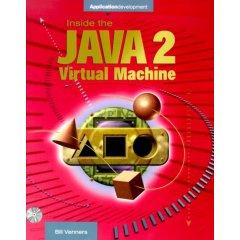| 2020ok Directory of FREE Online Books and FREE eBooks |
Free eBooks > Business & Investing > Careers > Job Hunting > General > Inside The Java Virtual Machine
Inside The Java Virtual Machineby Bill Venners  Download Book (Respecting the intellectual property of others is utmost important to us, we make every effort to make sure we only link to legitimate sites, such as those sites owned by authors and publishers. If you have any questions about these links, please contact us.) link 1 About Book Amazon.com For the advanced Java developer, Inside the Java 2 Virtual Machine offers a detailed guide to the inner workings of today's Java Virtual Machines (JVMs), plus a complete reference to all bytecodes (the "machine code" for the language). For those who want to understand how Java really works, this book definitely delivers the goods, with excellent technical detail and demos of JVMs in action on the companion CD-ROM. This title provides a remarkably detailed tour of the internals of the Java platform, with plenty of technical information on the way virtual machines do business under the hood, from the way language statements are turned into bytecodes to in-depth coverage of loading and invoking classes, security, and garbage collection. The author demonstrates superior knowledge of Sun's Java Virtual Machine specification and explains the principles of its design and implementation, including a full explanation of how actual bytecodes are run on a VM. (Surprisingly, variables in Java are always processed on the stack, since there are no general CPU registers available, a very different architecture than most CPUs.) Each chapter includes applets that showcase Java in action (for example, adding two numbers or demonstrating garbage collection). The later part of this text covers over 200 Java bytecodes (mnemonic instructions for the JVM) by groups, and the book closes with a full listing of these opcodes (with over 150 pages of material). In all, Inside the Java 2 Virtual Machine serves as both a tutorial and reference to the architecture and inner operation of JVMs for any technically astute reader who wants to understand how Java really works. --Richard Dragan Topics covered: Java Virtual Machine (JVM) class architecture, the Java class loader, tips for platform independence, Java security, verifying class files, code-signing, network mobility, Jini basics, the organization of Java .class files, Java object lifetimes, the linking model, garbage collection basics and algorithms, stack operations, type conversions, integer and floating-point arithmetic, objects and arrays, control flow, exceptions and finally clauses, method invocation, thread synchronization, Java opcode and quickcode reference, and JVM simulation demos.
Want to Write Better Java Programs? Look Under the Hood and See What Makes the Ingenious Java Engine Run! This in-depth guide to Java's architecture and internals is your key to writing more effective and efficient Java code. By understanding the Java Virtual Machine (JVM), you will gain insights into the inner workings of Java technology that will help you harness the full range of Java's capabilities in your programs. In addition, this comprehensive volume explains the architecture of the JVM, including the interaction of the Java stack, the heap, the method area, and the execution engine. It includes in-depth discussions of various implementation techniques, such as interpreting, just-in-time compiling, and adaptive optimization. It also describes the behavior of Java threads and the Java monitor. It also covers garbage collection, including reference objects, the train algorithm, and object finalization. Finally the intricacies of the Java security model are discussed, including type safety, the class loader architecture, class verifier, security manager, access controller, and code signing. With this guide, you'll understand Java's linking model dynamic extension, and you'll learn how to write class loaders. You'll also uncover the seven steps to writing a platform independent Java program. About the Author Bill Venners (Mountain View, CA) is an 11-year Silicon Valley veteran. He has developed software for the consumer electronics, semiconductor, and life insurance industries and is currently focused on Java—writing a column titled "Under the Hood" for JavaWorld. Bill is president of his own custom software development and consulting firm. Related Free eBooks
| Related Tags |












SEND A COMMENT
PLEASE READ: All comments must be approved before appearing in the thread; time and space constraints prevent all comments from appearing. We will only approve comments that are directly related to the article, use appropriate language and are not attacking the comments of others.